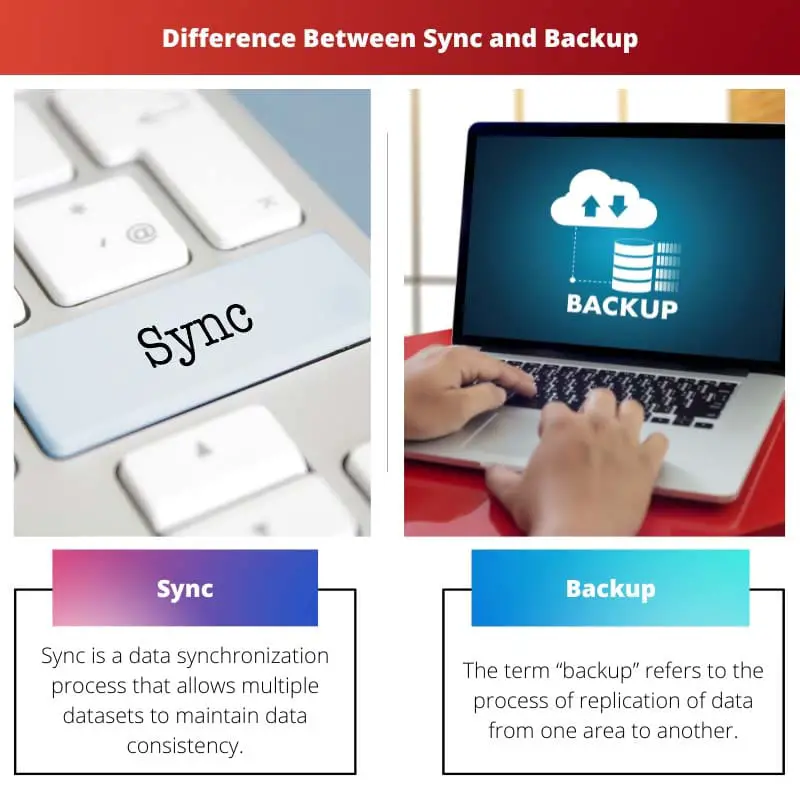Information management has changed since the beginning of the computing industry in the 1950s, and it remains a critical component of every organization and business continuity strategy today.
Synchronizing and backing up data are sometimes used interchangeably as data protection solutions, but there are important differences between the two, especially when it comes to information recovery,
that all business owners should be aware of.
Key Takeaways
- Sync ensures that two devices have the same updated version of files, while backup makes a copy of files for safekeeping in case of data loss.
- Sync involves exchanging data between two devices, while backup involves saving data to an external location or device.
- Syncing can overwrite newer versions of files with older ones, while backup preserves all versions of files.
Sync vs Backup
Sync is ensuring that two or more devices have the same up-to-date version of a file or folder to ensure that you can access the latest version from any device you use. Backup is the process of creating a copy of your data in case the original is lost, deleted, or damaged at the local storage.

Sync is a data synchronization process that allows multiple datasets to maintain data consistency. It is accomplished by copying and pasting the modifications back and forth.
This process of data synchronization is ongoing. Synchronizations come in a variety of forms.
If there are no suitable records in the target table with matching primary key values, new records from the source table are transferred to the target table.
The term “backup” refers to the process of replication of data from one area to another. Duplicating data from your computer to a computer hard disk, the web, a different computer, or a memory stick, for example.
Backing up files is the most conventional and dependable way for a company to secure its digital assets while also ensuring business continuity.
Comparison Table
| Parameters of Comparison | Sync | Backup |
|---|---|---|
| Definition | Sync is a data synchronization procedure that helps to maintain data integrity among two or more systems by replicating switches back and forth continuously. | A backup is a duplicate of data that may be used to recover the source in the case of a data loss. |
| Usage | Sync is a synchronization technique that helps to preserve data consistency across many databases. | Backup aids in the restoration of the database in the event of a failure. |
| Speed | Fewer files are copied every time | Files are copied every time |
| Data Recovery | Not being able to go back in the period before the information was lost. | Able to go back in the period before the information was lost. |
| Process | It is a two-way process. | It is a one-way process. |
What is Sync?
When two devices synchronize data, it indicates that they are merging the same, up-to-date, accessible information.
In the corporate world, the most prevalent example is the use of synchronization and sharing services like Dropbox, Boxes, Google Docs, OneDrive, and Evernote.
Information can be stored in an authorized data repository and accessible remotely by anybody with permission using PCs, laptops, tablets, or smartphones.
While syncing can be a very powerful tool to access and work on work, it’s best used in conjunction with another backup mechanism.
This is true for a variety of reasons, the first of which is that synchronized files might easily be misplaced due to the complexity of syncing directories between devices.
Also, installation can become unnecessarily complicated when you charge more for features that help improve your search capabilities, such as selectively syncing items.
Second, using one of these apps to sync your content does not make it resistant to ransomware attacks.
Assuming your information has been backed up, restoring information, web page, and permissions after a data loss or ransomware attack can be a lengthy and sometimes difficult procedure.

What is Backup?
A data backup is a duplicate of the original. It contains important database components such as administrative data and information files. Databases can have unanticipated failures.
Consequently, keeping a database backup is a better option. Having backups speeds up the recovery process.
Physical backups and logical backups are the two main types of backups. The duplicates of actual database files are known as physical backups.
It’s a duplicate of the document that stores database data in a different location. A logical database file is a type of logical backup. The logical data collected from a database is stored in those backups.
Here are some advantages of backing up your files: It can be automated, giving customers peace of mind that their data is safe without having to do anything.
Users do not need technical knowledge to perform tasks such as creating specific folders or entering commands in the command prompt.
Various-time-a-day backups create snapshots of your data, allowing users to access multiple copies of your material.
You don’t need on-premise infrastructure with cloud-managed offsite backups, and you can check on backup status from anywhere at any time. Anyone who has a large number of videos on their computer will benefit from backup.
Synchronization is used to connect to transport services with storage constraints. Most people choose to save space by storing files locally and then backing them up for safety.

Main Differences Between Sync and Backup
- Sync is a data synchronization method that helps maintain data integrity between two or more systems by constantly replicating switches. In the event of a data loss, a backup is a copy of the information that can be used to restore the original.
- Backup supports the recovery of the system in the case of a problem, whereas sync is a synchronizing strategy that helps to keep data consistency across several databases.
- In sync, fewer files are copied every time, whereas, in backup, files are copied every time.
- In sync, the file is not being able to return to a previous time period before the data was deleted, whereas a backup file able to return to a previous time period before the data was deleted.
- It’s a two-way process when it comes to synchronization. Backup, on the other hand, is a one-way procedure.





